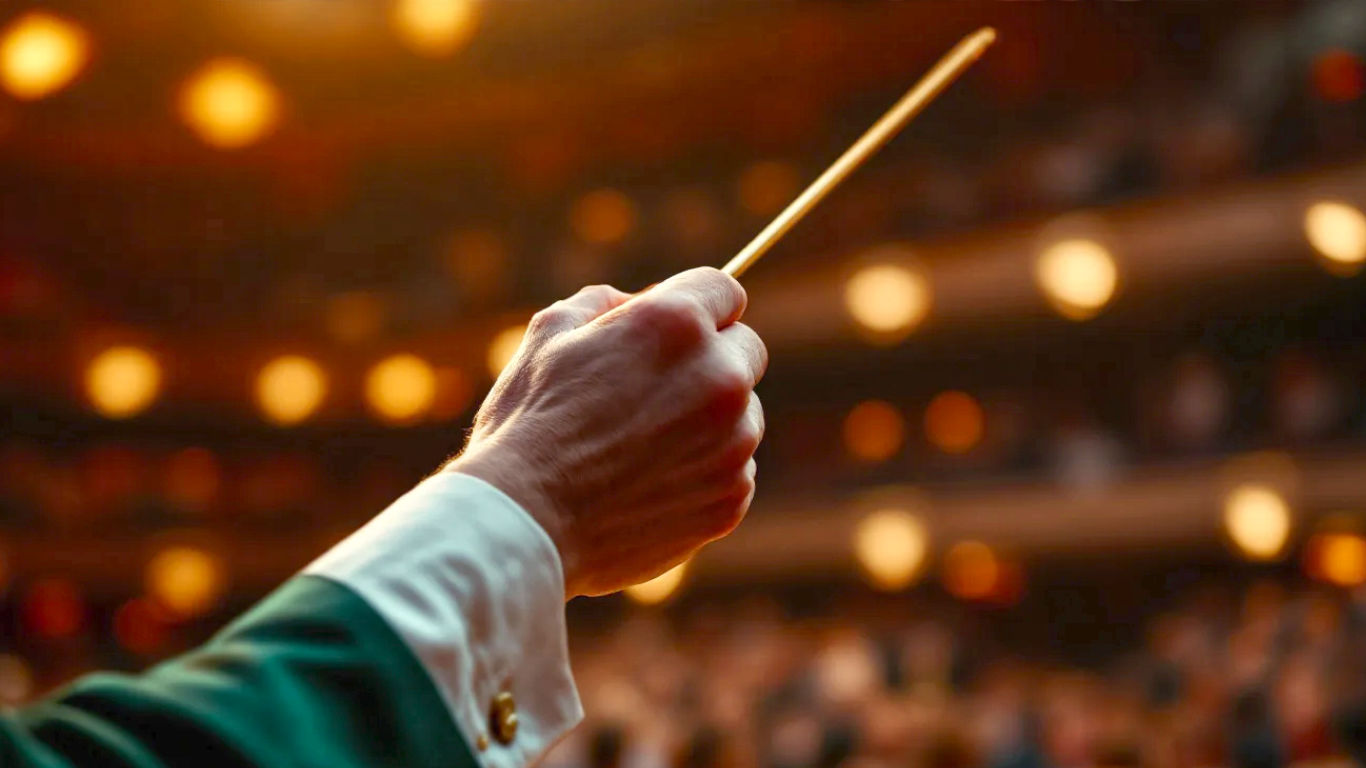The Conductor’s Baton: The Ultimate Guide to the Silent Storyteller of the Orchestra
A deep dive into the conductor’s baton. Explore its history, how it works, what it’s made of, and its iconic role in British culture like the Proms.

This post may contain affiliate links. If you make a purchase through these links, we may earn a commission at no additional cost to you.
Stand in the Royal Albert Hall on a Proms night. The air crackles with anticipation. A hundred musicians, instruments poised, sit ready. Thousands of audience members hold their breath. Then, a single figure raises a hand, and in it, a slender stick—no thicker than a pencil, no longer than your forearm. The stick hangs in the air for a heart-stopping moment, and then, with a flick of the wrist, it unleashes a thunderous wave of sound.
That little stick is the conductor’s baton.
For many, it’s a bit of a mystery. Is it a magic wand? A glorified metronome? Or just something for the conductor to wave about? The truth is, it’s a bit of all three, but so much more. The baton is one of the most powerful and misunderstood tools in music. It’s an instrument of nuance and control, a channel for emotion, and a symbol of leadership with a surprisingly dramatic and, at times, downright dangerous history.
This is the definitive guide to that little stick. We’ll uncover where it came from, how it actually works, what it’s made of, and why it holds such a special place in the world of classical music, especially here in Britain. So, let’s pull back the curtain on the silent storyteller of the orchestra.
What Is a Conductor’s Baton, Really?
At its simplest, a conductor’s baton is a tool used to magnify and clarify a conductor’s hand gestures. An orchestra can be huge, with musicians sitting dozens of feet away from the conductor. The small, white stick creates a clear focal point that’s easier for everyone to see than just a hand.
But thinking of it as a mere pointer is like saying a violin is just a wooden box with strings. The baton is an extension of the conductor’s arm, and by extension, their musical soul. It doesn’t make a sound itself, but it’s responsible for shaping every sound the orchestra makes.
Through the baton, a conductor communicates:
- Tempo: The speed of the music.
- Rhythm: The precise timing and beat.
- Dynamics: The volume, from a whisper (
pianissimo) to a roar (fortissimo). - Articulation: The style of the notes, whether they are sharp and detached (
staccato) or smooth and connected (legato). - Emotion: The overall character and feeling of the music.
It’s a silent instrument that ‘plays’ the orchestra itself. It unifies a hundred different musicians into a single, cohesive voice, turning a page of black dots into a living, breathing performance.
A Noisy Beginning: The History of the Conductor’s Baton
The elegant, lightweight baton we see today is a relatively modern invention. Before it existed, leading an orchestra was a much clumsier—and louder—affair.
Before the Baton: Hand Gestures and Noisy Time-Keeping
Let’s rewind a few centuries. In the medieval and Renaissance periods, choirs were often led by hand gestures known as cheironomy. The leader would use their hands to show the rise and fall of the melody, much like some choral conductors still do today.
By the Baroque era (roughly 1600–1750), orchestras were smaller. The person in charge was usually one of the musicians—often the harpsichordist, who would nod their head and gesture with a free hand, or the lead violinist (known as the concertmaster), who would use their bow to indicate the beat. It worked, but it wasn’t ideal.
As orchestras grew larger for the grand operas of the 17th and 18th centuries, a more forceful method was needed. Enter the original conductor’s ‘baton’: a massive wooden staff. The leader would stand at the front and thump this heavy staff on the floor to keep everyone in time. It was effective, but it was also incredibly noisy, adding a constant, percussive thud-thud-thud to the music.
It was also, as the French composer Jean-Baptiste Lully discovered in 1687, potentially lethal. While conducting a piece to celebrate the King’s recovery from surgery, Lully, known for his passionate style, struck his own foot with the heavy staff. The wound developed gangrene, and he died a few weeks later, making him the first—and hopefully last—conductor to be killed by his own ‘baton’.
The Rise of the Little Stick: From Paper Scrolls to a Proper Baton
Clearly, a change was needed. For a while, conductors used a rolled-up sheet of paper, which was visible but didn’t carry the risk of impalement. But the true birth of the modern baton happened in London.
In 1820, the German composer and conductor Louis Spohr was in London to conduct the Philharmonic Society. He was horrified by the old system where the pianist and the lead violinist would try to lead simultaneously. He wrote in his diary:
“I took my stand… drew my directing baton from my coat pocket and gave the signal to begin. A conductor’s direction of this kind was something unheard of.”
The orchestra was sceptical at first, but the performance was a triumph. The clarity and precision that Spohr achieved with his little stick were undeniable. The age of the baton had begun.
It was another German composer, Felix Mendelssohn, who really cemented its use. He was a champion of the baton and used it in his concerts across Europe, including in Britain, where he was incredibly popular. By the mid-19th century, as composers like Wagner and Berlioz wrote increasingly complex music for enormous orchestras, the silent, precise baton was no longer a novelty but a necessity.
The Conductor’s Toolkit: How the Baton Actually Works
So, how does a conductor use the baton to communicate so much information without saying a word? It’s all about a shared language of patterns and gestures that every orchestral musician learns to read.
Keeping Time: The Basics of Beat Patterns
The most fundamental job of the baton is to show the beat. The conductor does this by moving the baton in set patterns in the air, corresponding to the time signature of the music. The tip of the baton is the crucial point to watch.
Each beat has a clear ‘click’ point, which musicians call the ictus. This is the exact moment the beat happens.
Here are the most common patterns:
- Two beats per bar (2/4 time): Used for marches. The pattern is simple: DOWN – UP. The first beat is a strong downbeat, the second is a lighter upbeat.
- Three beats per bar (3/4 time): The pattern for a waltz. It’s a triangle shape: DOWN – RIGHT – UP.
- Four beats per bar (4/4 time): The most common time signature in music. The pattern is: DOWN – LEFT – RIGHT – UP.
The downbeat (beat one) is always the most important. It’s the anchor of the bar, and it’s always shown with a clear downward motion. The size of the pattern tells the orchestra everything about the tempo and volume. A fast piece will have small, crisp patterns. A slow, loud, epic piece will have huge, sweeping ones.
More Than a Metronome: Shaping the Sound
If keeping time was all the baton did, a machine could do it. The real artistry comes from how the conductor shapes the music between the beats.
- Dynamics (Loud and Soft): The size of the gesture is the key. A tiny, controlled movement from the wrist indicates a very quiet passage. A huge, powerful gesture involving the whole arm signals to the orchestra to play as loudly as possible.
- Articulation (Sharp and Smooth): The character of the movement shapes the character of the sound. A sharp, flicking motion will produce a short, spiky
staccatonote. A smooth, flowing, circular motion will encourage a rich, connectedlegatosound. - Cues: The conductor uses the baton to signal entries to specific musicians or sections. They will make eye contact with, say, the principal oboist, and give a clear but gentle gesture with the baton just before their solo begins. It’s a musical invitation: “You’re on.”
The Other Hand: What the Left Hand Does
You’ll notice that conductors almost always hold the baton in their right hand. The right hand is the timekeeper; it’s the business hand that lays down the rhythmic law.
The left hand is the hand of emotion and poetry. It’s used for gestures that the baton can’t quite manage. It might be raised with the palm open to ask for a softer, warmer sound from the strings. It might form a fist to demand more power from the brass. It can be brought up to the lips to signal “hush” or sweep across the orchestra to encourage a crescendo (getting louder).
The two hands work in tandem. The right hand provides the structure; the left hand provides the soul.
Anatomy of a Baton: What’s It Made Of?
From a distance, all batons look pretty much the same. Up close, however, they are highly specialised tools, and a conductor’s choice of baton is a deeply personal one.
The Parts of a Baton
A baton has two main parts:
- The Shaft: This is the long, thin part of the baton. Traditionally, they were made of wood, like birch or maple. Today, many conductors prefer modern materials. Fibreglass is very durable and less prone to snapping in a moment of passion. Carbon fibre is incredibly lightweight and strong, allowing for very fast, precise movements without tiring the arm. The shaft is almost always painted white for maximum visibility against the conductor’s dark clothing.
- The Handle (or Bulb): This is where the conductor holds the baton. It acts as a counterweight to the shaft. Handles come in many shapes (teardrop, round, oval) and are made from various materials. Cork is popular because it’s lightweight and absorbs sweat. Beautifully crafted hardwood handles (like rosewood or cocobolo) are also common.
The most important feature of any baton is its balance point. This is the point where the baton would balance perfectly on your finger. A well-balanced baton feels almost weightless in the hand, allowing the conductor to forget about the tool and focus entirely on the music.
Choosing a Baton: A Personal Decision
There is no ‘one size fits all’. The choice depends on many factors:
- The conductor’s size: A tall conductor with long arms (like Britain’s own Sir Adrian Boult) might prefer a longer baton (14-16 inches) to make their gestures clearer to a large orchestra. A smaller conductor might use a shorter one (10-12 inches).
- The music: A conductor might use a heavier, more substantial baton for a powerful Wagner opera and a lighter, quicker one for a delicate Mozart symphony.
- Personal feel: Ultimately, it comes down to what feels comfortable. It’s an intimate connection, and a conductor may try dozens of batons before finding the one that feels like a true extension of their hand.
The Maestro’s Mind: The Psychology of Wielding the Baton
The baton isn’t just a physical tool; it’s a powerful psychological one. It focuses the attention of a hundred highly skilled individuals onto a single point.
An Instrument of Authority
When the conductor steps onto the podium and raises the baton, it is a clear, non-verbal signal: “I am in charge. Listen to me. Follow me.” It’s a symbol of leadership, a sceptre that commands the respect and focus of the entire ensemble. This authority isn’t about being a dictator; it’s about earning the orchestra’s trust so they are willing to follow your musical vision.
The Silent Conversation
The best conducting is a two-way street. The conductor sends out signals with the baton, and the orchestra responds with sound. The conductor then listens to that sound and adjusts their gestures in real-time. It’s a constant, silent conversation.
A great conductor, like Sir Simon Rattle, is famous for their expressive face and body language. The baton is the focal point, but it works in harmony with the eyes, the posture, and the breath. When an orchestra trusts its conductor, they don’t just watch the baton; they watch the person. They respond not just to the beat pattern, but to the intent behind it. The baton becomes the conduit for that shared intent.
To Wield or Not to Wield: Conducting Without a Baton
Given all this, you might be surprised to learn that some conductors don’t use a baton at all.
When Hands Are Better
Choral conducting is a great example. With a choir, the conductor is often focused on shaping vowel sounds, indicating breathing, and conveying the meaning of the text—things that are often more sensitively expressed with the fingers and palms than with a wooden stick. The relationship with a choir is often more intimate, and a baton can feel like a barrier.
Some conductors also dispense with the baton for certain orchestral pieces, particularly contemporary ones with complex textures or when working with smaller chamber orchestras.
Famous Bare-Handed Conductors
Several famous conductors chose to work exclusively with their hands. Leopold Stokowski, the legendary conductor famous for his work with the Philadelphia Orchestra (and for shaking Mickey Mouse’s hand in the film Fantasia), was a notable example. He believed he could sculpt the sound more directly with his bare hands.
More recently, the French composer and conductor Pierre Boulez was renowned for his incredibly precise hand gestures, proving that a baton isn’t the only route to musical clarity. For these conductors, their ten fingers became ten batons.
The Baton in British Culture: More Than Just Music
In Britain, the image of the conductor with their baton is deeply ingrained in our cultural landscape, thanks in large part to one beloved institution: The BBC Proms.
The Iconic Image of the Proms
Founded in 1895 by conductor Sir Henry Wood, the Proms have made classical music accessible to millions. The festival’s conductor is a central figure, and the sight of them leading the orchestra and the “Prommers” at the Royal Albert Hall is an iconic part of the British summer. The “Last Night of the Proms” is a televised national event where the conductor’s baton doesn’t just lead the orchestra, but a flag-waving, singing audience of thousands. It transforms the baton into a symbol of shared celebration and national pride.
From Concert Hall to Pop Culture
Beyond the concert hall, the baton-wielding maestro has become a familiar character in popular culture. Think of cartoon characters like Bugs Bunny frantically conducting an opera, or the stereotypical image of the wild-haired, tyrannical genius. While often a caricature, it shows how deeply the image of the conductor and their baton has entered our collective imagination.
The Future of the Baton
In our technological age, is there still a place for such a simple tool?
Some changes are already happening. Many conductors now read the musical score from a tablet instead of a large paper book, eliminating the need for page turns. There are even virtual reality applications that allow aspiring conductors to practise leading a digital orchestra.
But these technologies are aids, not replacements. The fundamental act of conducting is about human connection. It’s about one person transmitting their interpretation of a piece of music to a group of other people through gesture and intent. A computer can keep perfect time, but it can’t inspire, console, or exhilarate. It can’t react to the unique acoustics of a hall or the mood of the orchestra on a particular night.
The baton has survived for 200 years because it does its job perfectly. It’s a simple, elegant solution to a complex problem: how to unite and inspire a large group of artists in a single, shared goal. It’s a technology that has yet to be bettered.
Conclusion: The Silent Storyteller
From a deadly thumping staff to a feather-light stick of carbon fibre, the conductor’s baton has had quite a journey. It has become far more than a simple time-keeping device. It is a tool of immense subtlety and power, capable of communicating the quietest whisper and the most earth-shattering roar.
The next time you’re watching an orchestra, whether it’s at the Royal Albert Hall or on television, pay close attention to that little white stick. Watch how it dances, jabs, and soars. It isn’t making a single sound, but it’s telling the most important story of all. It’s the silent storyteller, translating the composer’s vision into the glorious sound you hear, bringing music to life with a flick of the wrist.
Further Reading
For those wishing to explore the world of conducting and classical music further, these resources provide excellent information and insight from a British perspective:
- Classic FM: https://www.classicfm.com/discover-music/instruments/baton/ – An accessible and engaging resource for all things classical music.
- Gramophone Magazine: https://www.gramophone.co.uk/ – A highly respected publication offering in-depth reviews, articles, and interviews.
- The BBC Proms: https://www.bbc.co.uk/proms – The official website for the iconic British music festival.
- The London Symphony Orchestra Blog: https://lso.co.uk/whats-on/blog.html – Insights into the life of one of the world’s leading orchestras.
- Royal Philharmonic Orchestra – The Conductor’s Role: https://www.rpo.co.uk/about/the-orchestra/the-conductors-role – A direct explanation from a world-class orchestra.






